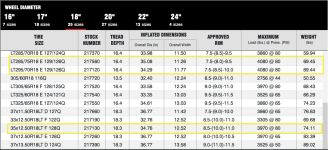booger
Bad
I've done a lot of towing but most of it was with a 1 ton DRW. When I got out of the big trailer towing business I got rid of the DRW. Now I have a Dodge 2500 4x4 on 35's. I added air bags to the rear and with my new 5th wheel camper it sits level. The trouble comes during cross winds and I'm trying to figure out how to help the sway situation. BTW the front of my truck does have 3" leveling spacers.
My 35's are load range D, I know it would help to go to E's. But if I have to buy another set of tires and wheels is it worth the trouble of going to G?
I'm looking at this using the 3,6,9 method if you're familiar. In this case that would look like this.
$3 method - Buy a set of load range E's that fit my rims.
$6 method - Buy a set of 19.5s and move over to G's.
$9 method - Buy a DRW axle, a bed, 6 tires and wheels.
I don't want to do all the steps, as that is the $18 method. But I want the family to be able to ride across country in this rig comfortably, maybe I just use the $1 NyQuil method on them and send it. Does anyone tow a 40' Toy hauler with a 3/4 ton that has made some adjustments similar to what I am considering?
My 35's are load range D, I know it would help to go to E's. But if I have to buy another set of tires and wheels is it worth the trouble of going to G?
I'm looking at this using the 3,6,9 method if you're familiar. In this case that would look like this.
$3 method - Buy a set of load range E's that fit my rims.
$6 method - Buy a set of 19.5s and move over to G's.
$9 method - Buy a DRW axle, a bed, 6 tires and wheels.
I don't want to do all the steps, as that is the $18 method. But I want the family to be able to ride across country in this rig comfortably, maybe I just use the $1 NyQuil method on them and send it. Does anyone tow a 40' Toy hauler with a 3/4 ton that has made some adjustments similar to what I am considering?



 You're already in the $20 method. A 3/4 ton dodge (guessing diesel) pulling a 40 foot toy hauler will need the transmission replaced within a year or two.
You're already in the $20 method. A 3/4 ton dodge (guessing diesel) pulling a 40 foot toy hauler will need the transmission replaced within a year or two.